A Slightly Obsessed Movie Theme Special!
Tears of a Clown
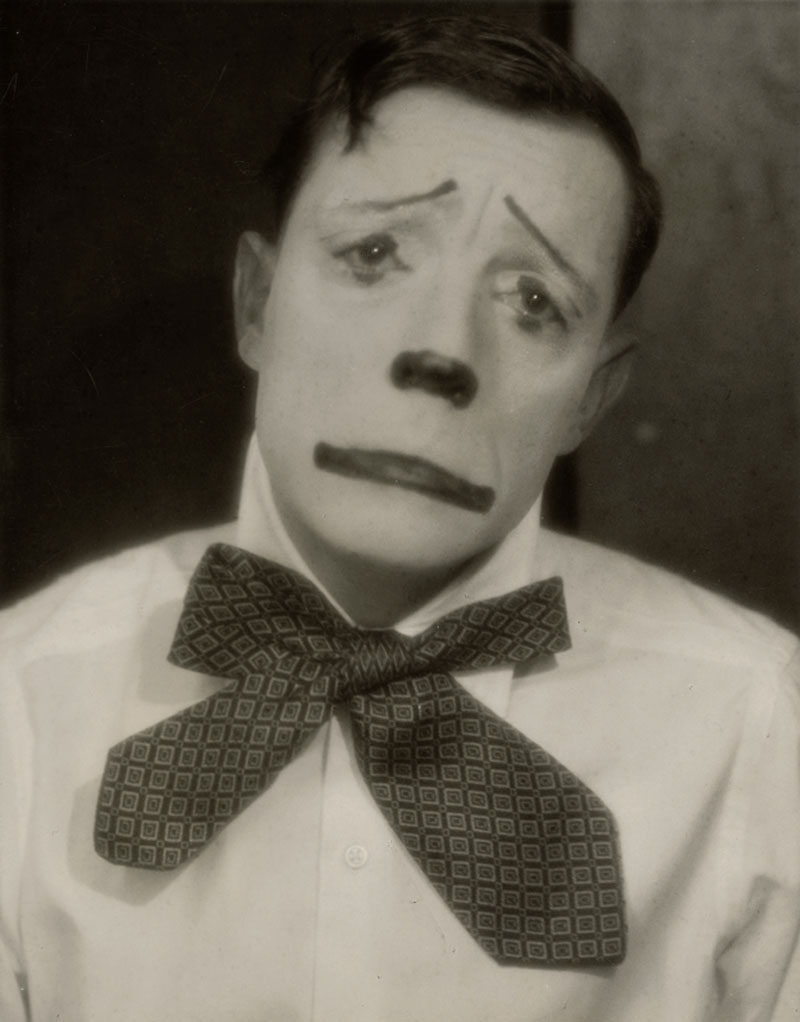
If one is to model oneself on The Greats, especially when it comes to writing about movies, I don’t suppose James Agee, Andre Bazin, Manny Farber, Pauline Kael, Andrew Sarris et al. ever bothered to get too personal, much less maudlin, in their film reviews. (Okay, well *maybe* Kael.)
Too unprofessional, one supposes.
Lacking the sophistication, insight, talent, and let’s say ‘writerly good sense’ of those illustrious and influential Film Reviewers—especially since I’m, y’know, doing this purely as a labor of love—guess one can be excused for, more and more of late, making one’s weekly claptrap less and less about the movies and more and more about the mopey-dopey schmo writing about ‘em!
…
So here goes: personally, in the wider realm of human affairs, I’m a big believer in the Invisible Caste System. THESE, I pronounce portentously, are the not-so-apparently apparent barriers of, say, philosophy, wealth, education, age, attractiveness—the list goes on—that separate and bind us to our respective roles in life. If, indeed, All Men Are Created Equal, then some of us, I daresay, are created a little more equally than others: “Some are born to sweet delight/Some are born to endless night.” And therein hangs the tale!
From being persona non grata through 13 years of public instruction to wending one’s weary way through 15+ years of overeducation, underemployment and expatriation—the persistent vantage of the Low Man On The Totem Pole, basically—I have, and here’s where I un-writerly tie all the irrelevancy above back to the actual subject matter at hand, found consistent refuge in movies.
The whole life-ness of life might suck, but dreams and visions, on the other hand, offer a wonderfully comforting escape.
…
For me, getting personal again, I was, from a very young age, drawn to screen misfits, outsiders and misanthropes.
As such, my viewing of old comedies, the type of movie that drew me to movies in the first place, became rather personal and quite possibly idiosyncratic:
On-screen, Charlie Chaplin struggled through a harsh world of deprivation and loneliness, Buster Keaton pratfalled his way through a mechanized world spinning rapidly out of control, Laurel & Hardy were two innocents cast adrift in an uncaring universe, W.C. Fields found sole comfort from the darker side of smalltown life—and, along with it, the American Dream of marriage & family—at the bottom of a bottle, Groucho Marx rapid-spitfired venomous insults and comebacks to all his many hecklers and tormentors; consistently proving the old adage that one person’s tragedy is a source of amusement to all but the person on the receiving end of it, the great comedians of old drew their timeless comedy from a deep reservoir of pain, suffering and unhappiness.
…
In that vein, this pre-Thanksgiving Sunday will be all about those movies that I cannot watch and reflect on without feeling a certain tinge of strong emotional reaction. Obviously, or not so obviously, I’m referring again to those comedy greats of old: Charlie Chaplin! Buster Keaton! Laurel & Hardy! W.C. Fields! The Marx Brothers! And too many more to list! Comedians who suffered on-screen torment and travail so that we might be entertained…
AND SO, as their example has provided something like a guiding light to this mopey-dopey, self-pitying life, I shall be expressing my gratitude to these not-so-merry mirthmakers during this Thanksgiving month with a write-up called, appropriately, Slapstick Sunday.

I. THE CIRCUS
(1928, United Artists, dir. Charlie Chaplin)
“The Little Tramp comes to town with The Circus!”
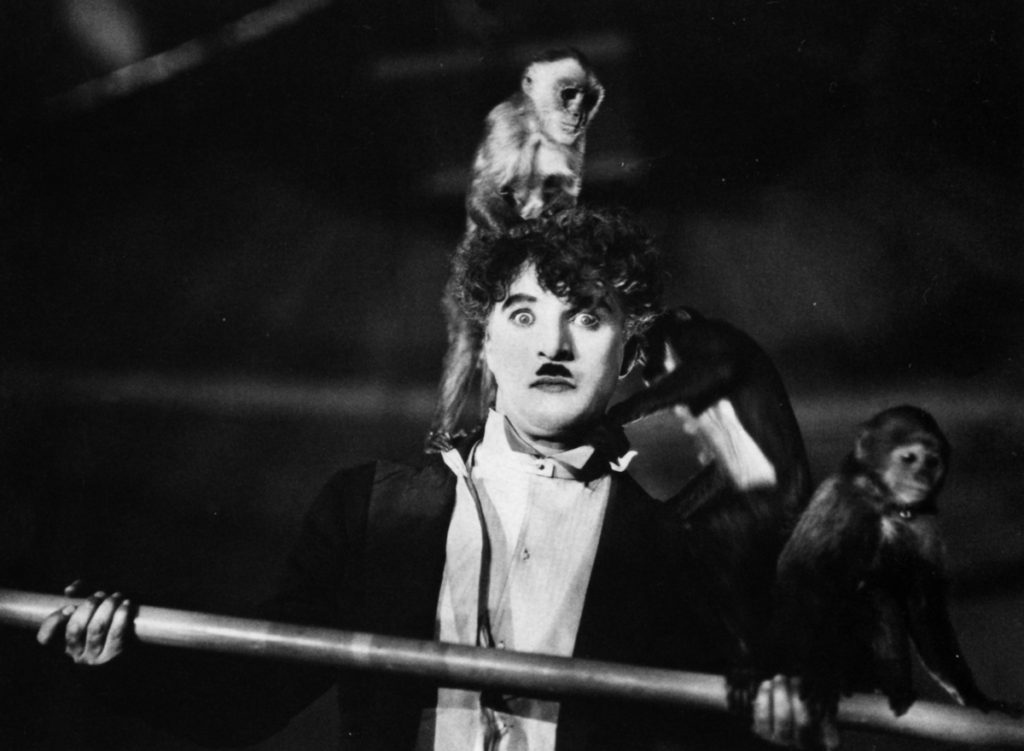
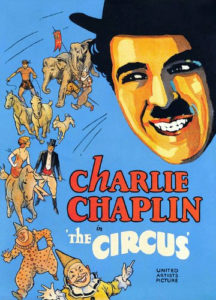 1928 January Issue of “Motion Picture Play”; Senior Staff Contributor, Cuthbert J. Twillie…
1928 January Issue of “Motion Picture Play”; Senior Staff Contributor, Cuthbert J. Twillie…
Three long years have passed since the appearance of a new Charlie Chaplin picture and what has the Little Tramp been up to in the meantime? Why, playing at The Circus, of course.
Turn to the front pages of this publication for T. Jasper Cunningham’s running commentary on salacious revelations from the Lita Grey divorce case and you will receive a pretty fair idea of how Charles Spencer Chaplin has been spending the interim, but fortunately the celluloid world of Charlie Chaplin continues to offer no such evidence of dark clouds on its sunnyside horizon. Twitching moustache, bowler hat, springy cane, tight waistcoat, and baggy pants fully intact, The Little Tramp takes yet another delightful detour on the lonely road of life, this time on the circus midway, to entertain film and comedy audiences the world over.
And most entertaining it is, too! Plot aside (and it usually is), Mr. Chaplin devises some of his best comic set-pieces yet,—including a gaspingly hilarious chase through a fun house of mirrors and a frightening encounter with a caged lion—culminating in a sequence to rival the best thrilling passages of Harold Lloyd or Douglas Fairbanks in which poor Charlie is caught on a tightrope and overrun by a havoc of escaped howler monkeys!
As always, there are tears among the laughter—the finale to this grand procession of hijinks and hilarity is quietly devastating in its forlorn wistfulness—but as any film fan knows, The Little Tramp always rebounds with a high-stepping kick-start, wresting victory from the jaws of defeat or, more appropriately, resolve from the quivering maw of rejection, and waddles off into the sunlit cheer of yet another Grand Adventure.
Let us just hope that’s it not another 3 years *(“Collected ‘Motion Picture Play’: 1920 – 1980”… Unfortunately, it was. (ed.))* before we once again encounter Little Charlie on The Road to mirth and merry-making, shall we?
…
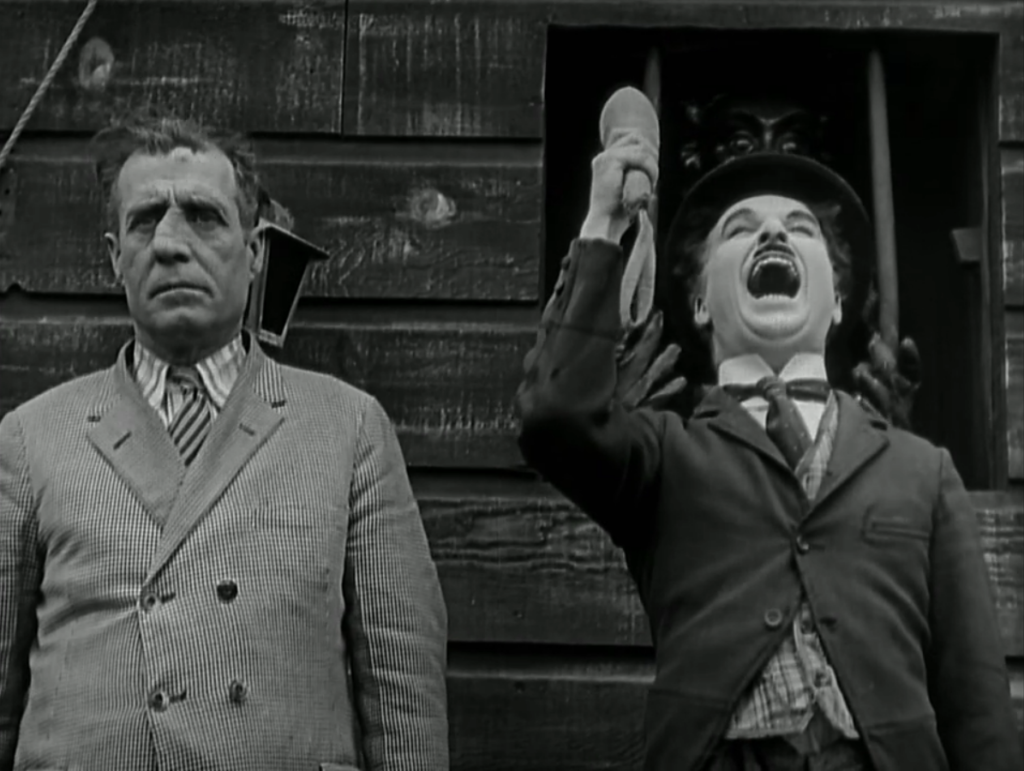
I’ve had a personal running reflection for most of my life on why—or why not—the Great Movie Circus Epic has never been made. Sure, Cecil B. DeMille came out with his Best Picture-winning The Greatest Show on Earth (1952) and I suppose there have been a *few* others, but none have really captured the public imagination in the grandiloquent manner that the Supreme! Colossal! Stupendous! Overwhelming! subject of The Great American Circus so richly deserves. Really, if there’s an aspect of Americana that needs, nay, *demands* its Gone With The Wind it’s the as-yet unplumbed mega-superlative terrain of Messrs. Barnum & Bailey—and, as a child of Wisconsin, lest I forget to mention Baraboo, WI’s own quintet of gloriously and improbably-mustachioed Ringling Bros. (“From the wintry wilds of Wisconsin to the World’s Whizbang of Wonderment!” *sigh* I really should be writing ad copy in about 1902.)
But for my money, Chaplin’s The Circus comes awfully close. Perhaps not as memorable as The Gold Rush (1925), nor as accomplished as Chaplin’s later City Lights (1931), Chaplin’s tribute to the sawdust & tinsel days of travelling circuses has charms of its own as a meticulously-constructed comedy that includes some of his most memorable gags (see fake vintage film review above). For pure laughs, especially the conceit that Charlie’s Little Tramp character is far funnier, without even trying, than the circus’s actual clowns (who are never actually funny by the way; ‘circus clowns,’ I mean), Chaplin might just have made his most mirth-making Masterpiece.
But what really sells this movie for me is the ending. Early on in his film career, Chaplin came up with the image of The Little Tramp wandering off into the sunset; alone, dejected, defeated. Here, though, the loneliness, defeat and dejection is just as strong as the circus pulls up stakes and leaves him behind—standing on the ash pile where the tents but scant hours previously stood—but this time there’s a bounce in his step as he scissor-kicks (a typical Chaplin gesture) the memento of his lost love—a paper star that she, a trapeze artist played by Merna Kennedy, used to jump through on her entrance to the circus’s center ring—that suggests that this poor fool, a true-life clown, is simply immune to life’s troubles.
Or not? Doesn’t really matter; he makes us laugh and, though his back is turned to us, the audience, we can imagine that the Little Tramp is once again smiling through his pain and is off to yet another Sunnyside Idyll on life’s grand procession of tears and laughter.
II. THE GENERAL
(1926, United Artists, dir(s). Buster Keaton & Clyde Bruckman)
“Johnnie Gray loved two things: his engine and his girl. (In that order.)”
“If you lose this war don’t blame me.”
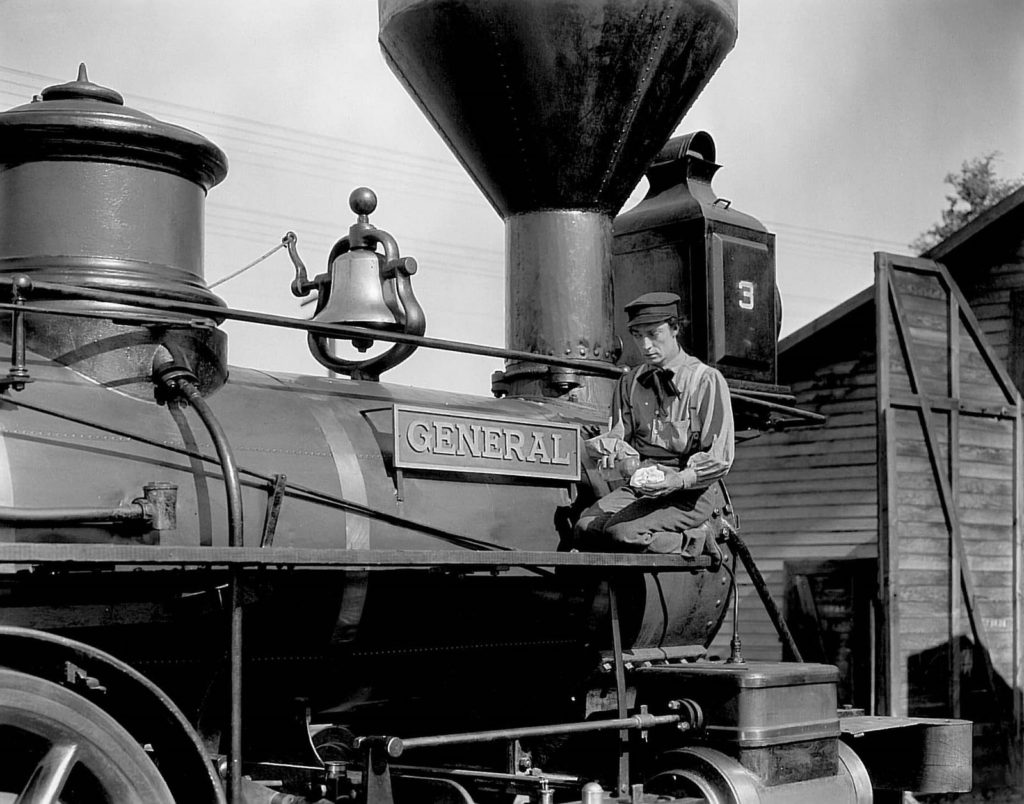
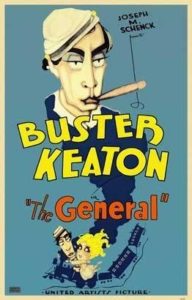 1926 December Issue of “Motion Picture Play”; Junior Staff Contributor, Cuthbert J. Twillie…
1926 December Issue of “Motion Picture Play”; Junior Staff Contributor, Cuthbert J. Twillie…
Legend has it young Keaton was gifted his cognomen by none other than Harry Houdini who, observing the then-1& 1/2 year old veteran vaudevillian taking a fall down a flight of stairs, and leaping to his feet entirely unscathed, was heard to remark, “That was a real buster!” Since then, after entering the movies opposite Roscoe “Fatty” Arbuckle and subsequently striking out on his own with producer Joseph M. Schenk, Mr. Keaton has perfected the taking of on-screen “busters” to the level of an artform.
In his latest display of physical derring-do and technical know-how, Buster Keaton turns his attention to American History, the War Between the States, ‘playing’—the double-meaning is entirely appropriate here—the engineer of a train called “The General.” At the outset of the war, Keaton as “Johnnie Gray,” a confederate denied entrance to the infantry due to his expertise as an engineer, witnesses his beloved General nefariously hi-jacked, along with his girl (Annabelle Lee), by a gang of Union Spies. The rest of the picture involves the erstwhile engineer giving chase to his stolen engine, recovering his precious train (and of course rescuing his girl), and finally crossing battle lines with the Ol’ General (and with, parenthetically, his girl in tow) to warn the Confederate Command of an imminent Union attack.
Spectacle, comedy, and war may seem an uncomfortable mix, but as Charlie Chaplin proved eight years ago with his immortal World War comedy Shoulder Arms, and as his brother Sydney has shown earlier this year in Warner Brother’s The Better ‘Ole, the terrors of armed conflict and the joys of slapstick shenanigans are not necessarily incompatible. Preview audiences appeared a trifle nonplussed by Keaton’s dramatic departure from his usual fallabout fantasies, but one suspects that the mechanical marvels that screendom’s great human automaton has depicted here—the breathless chase over breath-taking mountainous terrain; the precision timing of gags involving loaded cannons, upended railroad ties, and burning bridges; and, ultimately, the physical grace with which Buster effortlessly races back and forth over his train—will prove indelible for future generations of filmgoers.
Far as “Busters” go, this may prove his most resilient yet.
…
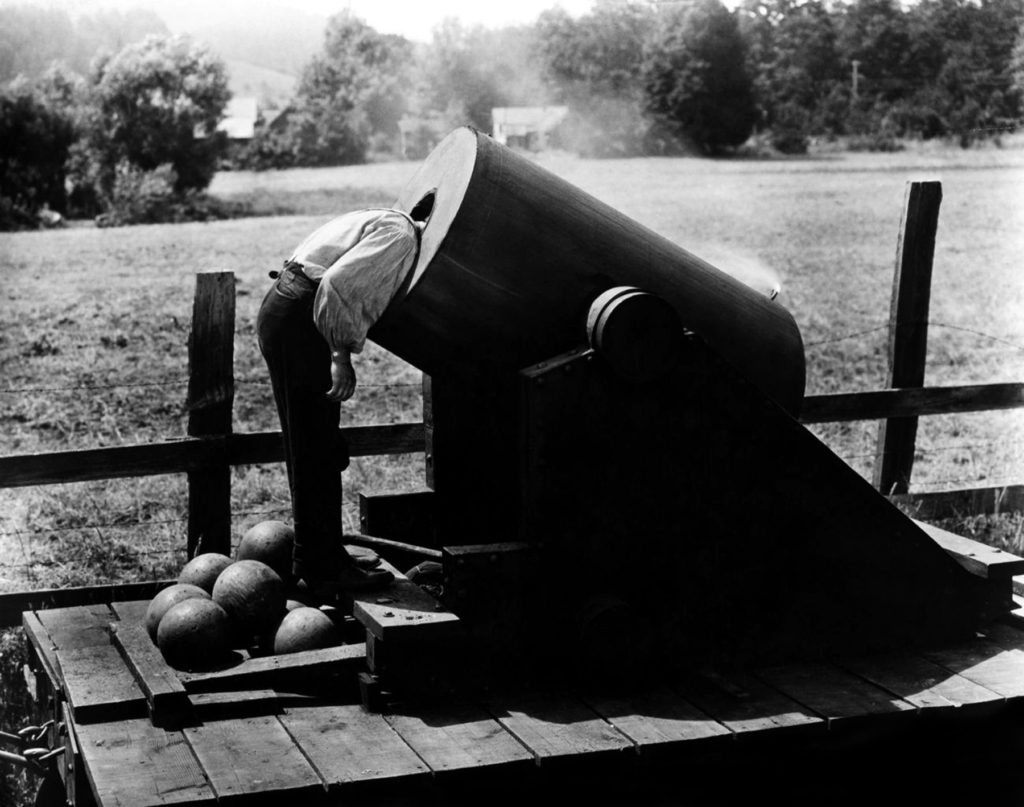
In finding the best way to explain the timeless appeal of Buster Keaton I’ve decided to use the analogy of that one kid you knew growing up, usually a boy (not to cast any gender assumptions), who quietly sat in corners making elaborate buildings, cities, entire civilizations even, with nothing but a few packs of Legos, Construx, or (more recently) Magna-tiles. What he, or occasionally ‘she,’ lacked for in conversation he, and sometimes ‘she,’ more than made up for in imagination and vision; the kind of kid you might imagine who thinks in shapes, numbers, and colors rather than words.
The story goes that Buster Keaton, as a 17-year veteran of vaudeville (he was, non-coincidentally, 17 years old at the time), decided to become a movie-maker after taking home a motion-picture camera, disassembling it, examining its inner workings, and then reassembling the whole schmear in perfect working order–even adding a few improvements, apparently, in the placement of the lens and the sprockets.
For someone (me) who is stymied even in changing the sticker tape on the pricing gun at work, this is truly an astonishing, mind-boggling feat.
Over the course of his silent movie career, Buster’s physical prowess—the man leaped, fell, somersaulted, and flipped with the precision timing of one of his beloved mechanical gizmos—greatly aided the elaborate fantasies he would construct out of the settings, props, and giant toys that made up his created world.

With a re-created Civil War battle raging in the far left of the screen, this astonishing shot (delayed over the course of an entire week’s shooting by inclement weather) required the bridge to collapse PRECISELY as the train engine rolled over it.
In a film era where “world-building” and “cinematic universes” are increasing buzzwords at the box office, Buster Keaton wholly “constructed” the sorts of movies you might imagine that one kid playing with those Legos might make if he (or she) grew up and got his (or her) own movie studio. (The latter, actually, is exactly what happened to Keaton, thanks to his producer during the 1920’s, Joseph M. Schenk.) Indeed, with a style and economy that modern filmmakers could learn much from, Buster was coming-on 100 years ahead of the curve with movies that moved with the blistering intensity and mechanical marvel of anything off Henry Ford’s assembly line.
In this vein, Buster made entire comedies where the human characters were actually less important than the machines and buildings he placed at the center of the action: in 1917’s One Week it was building a house within the time-frame of the title, in 1921’s Playhouse it was an astonishingly self-duplicated theatrical performance, in 1923’s Balloonatics it was a harrowing hot-air balloon ride, in 1924’s The Navigator it was “navigating” an entire ocean liner, in 1924’s Sherlock Jr. it was a movie screen through which Buster Keaton magically “stepped” through as a portal to another world, that of ‘film’ itself; all culminating in the high-mark of Keaton’s mechanical vision and technical know-how, in which The Great Stone Face adapted a little-known episode of American history to commandeer the engine of a train.
…
The General, a box office failure in its initial release, is also one of the great war comedies. And I certainly do not intend to sound pedantic in asserting that “war” and “comedy” are in fact *not* mutually exclusive, but I’d suggest that the very edginess and action-oriented drama of a war-time chase of locomotives across battle-lines, explosions and dangerous (but scenic and pretty) terrain, i.e. those qualities which made the movie hard for contemporary audiences to take in 1926, are precisely the qualities which so endear it to modern audiences.
As probably, outside of Fritz Lang’s Metropolis (1927), THE most well-known and re-shown silent movie of all time, Buster Keaton’s modern sensibility, part and parcel with his physical prowess and mechanical genius, continues to resonate with filmgoers to this day.
Also, it’s just amazing how all these goings-on NOT ONCE betray the tiniest flicker of emotion across Keaton’s wonderfully impassive face. Fortunately, the same does not in the least hold true for viewers of his singularly accomplished and brilliantly constructed comedies.
III. INTERNATIONAL HOUSE/THE OLD-FASHIONED WAY/IT’S A GIFT/NEVER GIVE A SUCKER AN EVEN BREAK
(1933, 1934, 1934, 1941; Paramount/Universal; dir(s). A. Edward Sutherland, William Beaudine, Norman McLeod, Edward Cline)
“Godfrey Daniel!”
“Mother-of-Pearl!”
“Shades of Bacchus!”
“Meshach and Abednego!”
“Suffering Sciatica!”
“DRAT!”
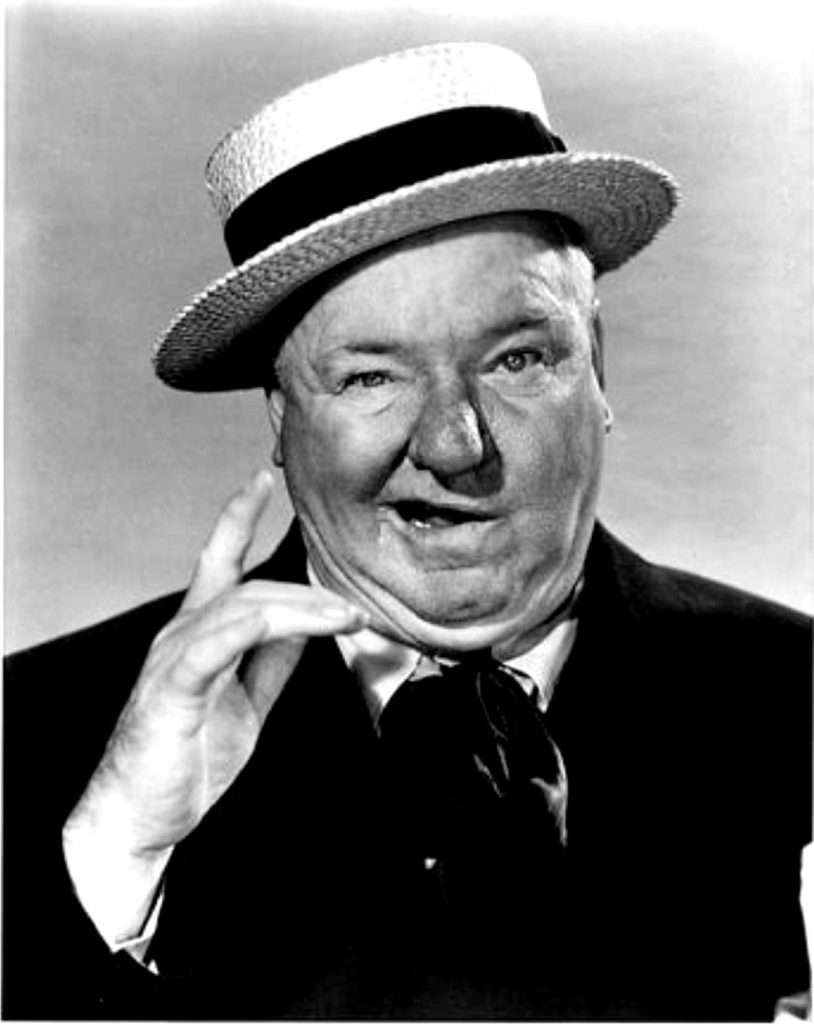
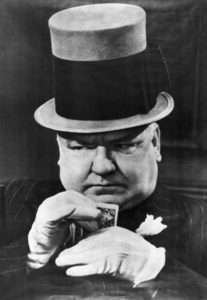 October 1938 Issue of “Motion Picture Play”; Rumor-Monger Extraordinaire, Sneed Hern…
October 1938 Issue of “Motion Picture Play”; Rumor-Monger Extraordinaire, Sneed Hern…
“WIZARD Destroys OZ”
W.C. Fields, the self-styled Great Man of Comedy, wreaked his own brand of inimitable havoc on the set of MGM’s upcoming musical/fantasy Technicolor extravaganza, “The Wizard of Oz,” leaving the production of this long in-development property seriously in doubt.
Fields, cast in the dual role of a traveling carnie huckster and The Wonderful Wizard himself, arrived on the film’s first day of shooting in a state of inebriation, twirling a top hat in his hand and inquiring of the studio guard at the gate, “Is this the way to Kansas City, Kansas or the way to Kansas City, Missour-ah?” When the guard suggested that Fields might be lost, or possibly confused, the puckish rogue was heard to loftily reply, “Kansas City is lost, I am HERE!”, before pushing the guard down a flight of stairs and forcing his way through the gate with a ball-tipped cane.
On set, Fields was taciturn and irksome in turn; referring to co-star Deanna Durbin, cast in the role of Dorothy, as “an insufferable child” and “off-key canary,” while reserving his greatest opprobrium for director Richard Thorpe, who Fields claimed “couldn’t find an interesting angle to film on Mae West.” (When the Cairn Terrier playing the role of “Toto” daintily pranced by, necessitating Fields to leap out of its way, the comedian proclaimed a distinct liking for all dogs: “fried.” As for his remarks about the small actors playing The Munchkins or his reaction to the sickeningly green make-up of co-star Margaret Hamilton, playing the Wicked Witch of the West, this reporter will refrain from repeating out of consideration for the more sensitive subscribers of this publication.)
But the tensions mounted to a head when song-and-dance man Buddy Ebsen, cast as The Tin Man, accepted a proffered drink from Fields’ mysterious hip-flask (“Just a small libation from a vat of Good Cheer my old grandpappy drowned in back in ’93. Death where is thy sting?”) which soon sent the genial hoofer into spasmodic convulsions, necessitating his immediate removal from the set. A frantic rush to the Culver City Hospital ensued, with Fields commandeering the ambulance, shouting “Road Hogs!” and forcing passing cars off the road the entire way, before the beleaguered Ebsen was miraculously restored at his moment of last extremity by imbibing an even-more mysterious substance drawn from the inner recesses of Fields’ brass buttoned-coat, which the latter claimed was a “tonsorial bought off a Ubangi in Albuquerque. Or possibly a Pygmy in Passamaquoddy…”
And then, well, matters descended from there into recondite inscrutability.
The upshot of all this Fieldsian Madness is that Durbin, Thorpe, Ebsen, and Fields are OUT; Judy Garland, director Victor Fleming, soft-shoe artist Jack Haley, and MGM contract player Ralph Morgan are IN.
One hopes the all-powerful OZ can recover from its near-fatal brush with GREATNESS.
…
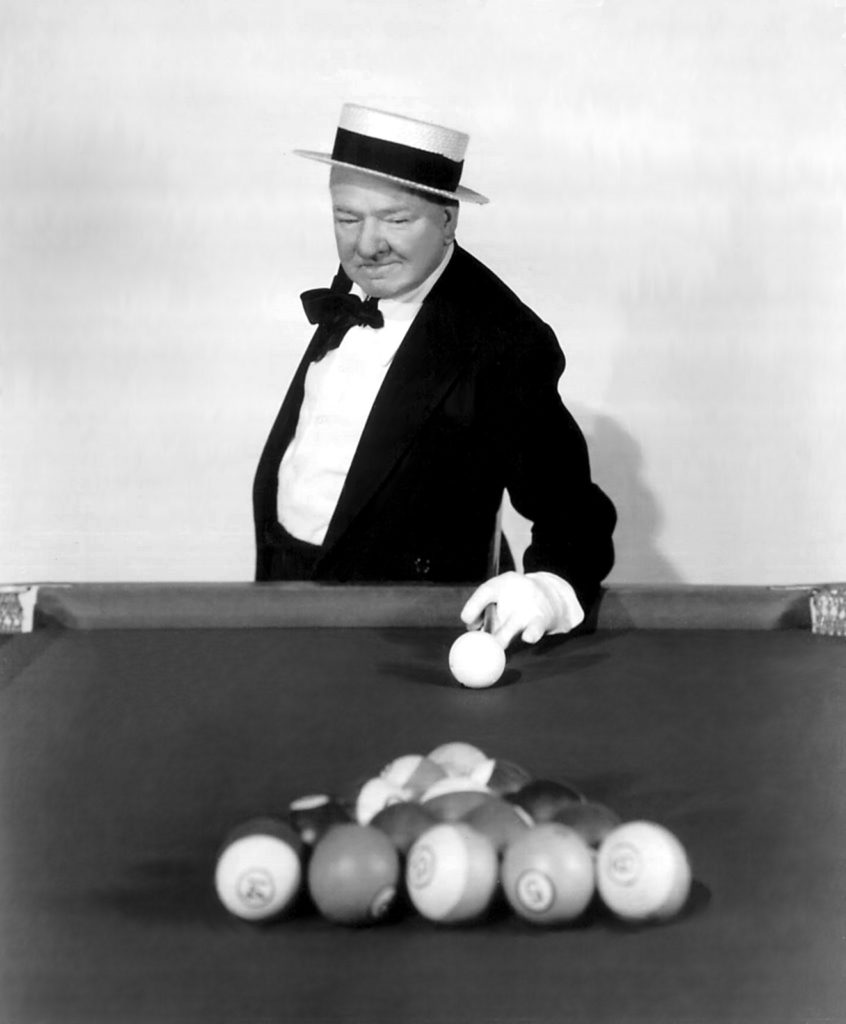
W.C. Fields was many things—a great juggler, a pool hustler, a card sharp, a rambling raconteur, an imaginer of improbable pseudonyms, an erudite enthusiast of obscure phrasing—but one thing he certainly wasn’t was NICE. Described by the famously charitable and kindly comic author P.G. Wodehouse as a “human louse” (Fields returned the compliment by writing a screenplay under the pseudonym “Mahatma Kane Jeeves,” i.e. “My hat, my cane, Jeeves!”), The Great Man proved once and for always that a comedian needn’t be sympathetic or even halfway decent, personality-wise, to get an audience on His Side.
Renowned for his prodigious drinking, his loathing of small animals and children, his garbled insults and oily compliments (“You warbled, my little wren?”)—not to mention his famous/infamous bright red, gin-blossomed nose—Fields parlayed the nasty, unpleasant side of his personality to glorious comic effect in a film career that found its footing at Paramount Studios in the early 30’s, ending on a high note across town at Universal a decade later. Given the complexity of Fields’ personality and comic persona, I’ve decided that ONE film isn’t enough to give a correct impression of the man and his comedy, so that this time out I’ll need FOUR.
(Actually, I’d been looking for an excuse to binge-view on 30’s comedy, anyway—not that I need much of an excuse, that is. A boxed set of The Great Man’s comedies that came into a work a few months back provided the perfect excuse.)
And so…
INTERNATIONAL HOUSE (1933, Paramount)
 Fields, as drunken aviator/inventor “Professor Henry R. Quail,” steals the all-star show from top-billed vaudeville team George Burns & Gracie Allen in this bizarre 1930’s hodgepodge of pre-code hilarity and mirthful madness. (Bela Lugosi and Cab Calloway in the same movie? Yee-up.) This was the first movie where Fields, cantankerous and exasperating as always, really came into his own, developing a unique style of comedy out of nastiness, innuendo, and—cane a-twirlin’, top hat a-wavin’—‘graceful gracelessness.’
Fields, as drunken aviator/inventor “Professor Henry R. Quail,” steals the all-star show from top-billed vaudeville team George Burns & Gracie Allen in this bizarre 1930’s hodgepodge of pre-code hilarity and mirthful madness. (Bela Lugosi and Cab Calloway in the same movie? Yee-up.) This was the first movie where Fields, cantankerous and exasperating as always, really came into his own, developing a unique style of comedy out of nastiness, innuendo, and—cane a-twirlin’, top hat a-wavin’—‘graceful gracelessness.’
THE OLD-FASHIONED WAY (1934, Paramount)
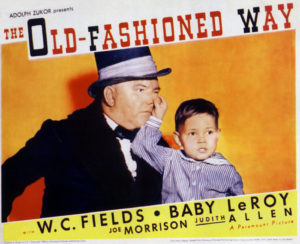 This ode to traveling theatre troupes of yesteryear hearkens back to Fields’ roots as a vaudeville performer and is particularly notable for containing the sole filmed record of Fields’ renowned juggling and cigar box act (the latter of which you really have to see to believe). “Huckster, con man, and fraud” were significant aspects to Fields’ on-screen persona—which is why he had been the very first actor considered for the role of The Wizard (see fake film article above) in The Wizard of Oz (1939); really, he would have been perfect—and The Great McGonigle’s pseudo-Victorian pronouncements such as “It ain’t a fit night for man nor beast!” roll off the Great Man’s tongue just exactly as if he’d just stepped out of the late nineteenth century.
This ode to traveling theatre troupes of yesteryear hearkens back to Fields’ roots as a vaudeville performer and is particularly notable for containing the sole filmed record of Fields’ renowned juggling and cigar box act (the latter of which you really have to see to believe). “Huckster, con man, and fraud” were significant aspects to Fields’ on-screen persona—which is why he had been the very first actor considered for the role of The Wizard (see fake film article above) in The Wizard of Oz (1939); really, he would have been perfect—and The Great McGonigle’s pseudo-Victorian pronouncements such as “It ain’t a fit night for man nor beast!” roll off the Great Man’s tongue just exactly as if he’d just stepped out of the late nineteenth century.
IT’S A GIFT (1934, Paramount)
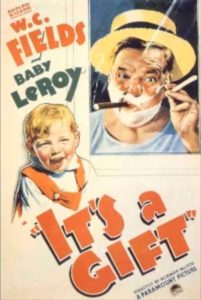 Possibly Fields’ masterpiece, hen-pecked grocer “Harold Bissonette” (“pronounced ‘Bisso-naaayyy’”) matches wits with a nagging wife (Kathleen Howard), small children (Baby LeRoy), lightbulbs, the blind (Charles Sellon), insurance agents (T. Roy Barnes), recalcitrant automobiles, a folding chair, and a picnic ground festooned with wrapping paper in this leisurely evisceration of small-town life, family, and the American Dream. Rarely—or, more accurately, never—has the word “kumquat” or the spelling of the name “LaFong” offered so rich and varied opportunities for wonderful comic nonsense…
Possibly Fields’ masterpiece, hen-pecked grocer “Harold Bissonette” (“pronounced ‘Bisso-naaayyy’”) matches wits with a nagging wife (Kathleen Howard), small children (Baby LeRoy), lightbulbs, the blind (Charles Sellon), insurance agents (T. Roy Barnes), recalcitrant automobiles, a folding chair, and a picnic ground festooned with wrapping paper in this leisurely evisceration of small-town life, family, and the American Dream. Rarely—or, more accurately, never—has the word “kumquat” or the spelling of the name “LaFong” offered so rich and varied opportunities for wonderful comic nonsense…
NEVER GIVE A SUCKER AN EVEN BREAK (1941, Universal)
 Starring The Great Man as Himself, Fields suffers the indignities of a career in rapid decline as “Esoteric Studios” refuses his last screen treatment—which includes such memorable comic notions as an open-air smoking lounge on a jet liner and a mountain-nest retreat where resides a beautiful girl and her hideous gorgon of a mother (Groucho Marx’s frequent foil, Margaret Dumont); in addition to the introduction of a game best-not-described called “squigelum”—before fleeing Hollywood forever, singing niece (the truly insufferable Gloria Jean) in tow. Great performers are rarely afforded an equally great career epilogue, but The Great Man’s final film-starring role functions as a valiant valedictory to sustained lunacy and comic frustration.
Starring The Great Man as Himself, Fields suffers the indignities of a career in rapid decline as “Esoteric Studios” refuses his last screen treatment—which includes such memorable comic notions as an open-air smoking lounge on a jet liner and a mountain-nest retreat where resides a beautiful girl and her hideous gorgon of a mother (Groucho Marx’s frequent foil, Margaret Dumont); in addition to the introduction of a game best-not-described called “squigelum”—before fleeing Hollywood forever, singing niece (the truly insufferable Gloria Jean) in tow. Great performers are rarely afforded an equally great career epilogue, but The Great Man’s final film-starring role functions as a valiant valedictory to sustained lunacy and comic frustration.
…
I suppose The Great Man, no stranger to random discursions himself, would forgive one for going on at such lengths… If nothing else, here’s hoping that essaying a singularly unpleasant life needn’t exclude one from the sustaining solace of great comedy.
IV. ANIMAL CRACKERS
(1930, Paramount Pictures, dir. Victor Heerman)
“Well, art is art, isn’t it? Still, on the other hand, water is water. And east is east and west is west, and if you take cranberries and stew them like applesauce they taste much more like prunes than rhubarb does.”
“Now, how do you wanna play—honest?”
“You said a lot of things I didn’t think were important, so I just omitted them.”
*HONK*

 1930 August Issue of “Motion Picture Play”; Editor-in-Chief, Cuthbert J. Twillie…
1930 August Issue of “Motion Picture Play”; Editor-in-Chief, Cuthbert J. Twillie…
The irrepressible Marx Brothers—Groucho, Chico, Harpo AND Zeppo—are back in Paramount Pictures’ production of their smash Broadway success, Animal Crackers. Following on the heels of last year’sThe Cocoanuts, The Boys once again take screen comedy to dizzying new heights of witty wordplay, blatant disregard for dramatic decorum, and inspired lunacy.
The story goes, or rather dilly-daddles, that a famed explorer, Captain Spaulding (Groucho), and his secretary, Jamison (Zeppo), have recently returned from a tour of Africa (where the former claims one morning to have “shot an elephant in my pajamas. How he got in my pajamas, I don’t know.”) to attend/derail the midnight soiree of Long Island socialite, Mrs. Rittenhouse (Margaret Dumont). Also disrupting the high society goings-on are two ne’er-do-well itinerant musicians, Signor Emmanuel Ravelli (Chico) and The Professor (Harpo), who are soon caught up in, and between, various plots to steal/substitute/dispose of multiple fakeries of a famous painting to be unveiled at the party.
Plot disposed of, and it usually is, the preposterous proceedings give way, break apart and collapse in ravaged response to Groucho’s rapid-fire one-liners, Chico’s flim-flammery, and silent Harpo’s slapstick antics; one suspects when the party guests are ‘flitted’ (‘flisked’? ‘fleshed’? ‘flasked’?) at the end of the movie, thanks to Harpo’s spray gun, that not a-one of ‘em is gonna rise for an encore!
Except for the risibly riotous Marx Brothers, that is, proving once and for all that cockeyed craziness and madcap mayhem is best kept in the family.
…
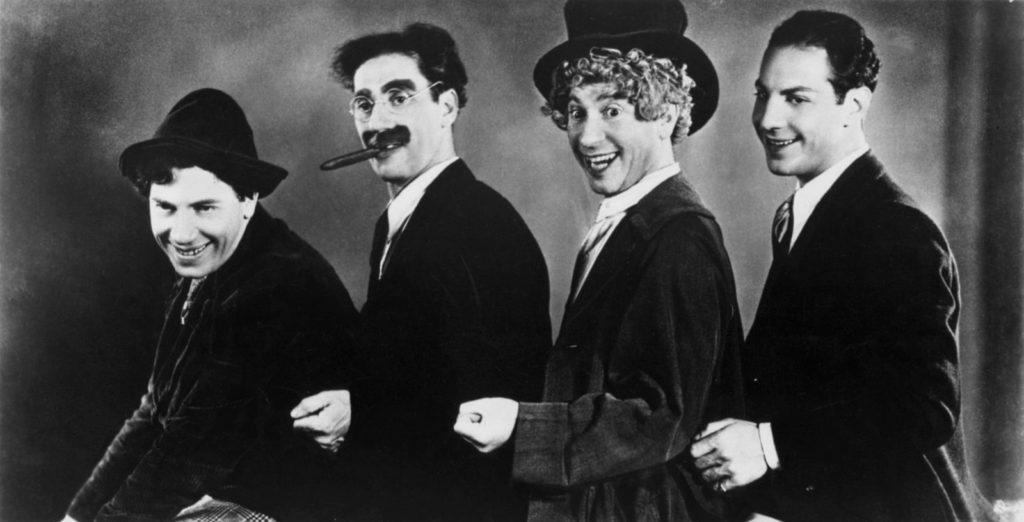
So I saved the Marx Brothers for this final entry on slapstick shenanigans as they were, truth be told, the very classic movie comedy act that inspired a lifelong love affair—or as close as I’ve ever gotten to that sort of thing—with classic movies, comedy, and oldtime-y show business. (Also, I’ve chosen this particular Marx Brothers movie, which is far from their best, merely because it is the first black & white movie I can recall that, at the age of 6 or 7, I actually sat all the way through.)
From veteran vaudevillians to the Toasts of Broadway, the Marx Brothers were astonishingly in their late 30s/early 40s (except for young Zeppo, who was never essential to the act, often understudying his brothers’ roles) when they started making movies. Sound had been introduced to movies two years before, and the act’s fast-paced verbal stylizing—heavy on logic-defying puns and word play—and anti-establishment rebelliousness were poised to revolutionize screen comedy.
Which they did.
In order of appearance, then, I give you the 4 Marx Bros.:
GROUCHO
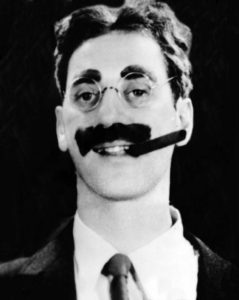 With his painted mustache and eyebrows—along with his ever-present cigar, wire-rimmed spectacles, oversized tuxedo, and hunched-over, stalking stride—Groucho Marx is perhaps the most recognizable and widely-quoted screen comedian of the classic movie era. Paired with/against imperious screen foils like the haughty society dowager Margaret Dumont, Groucho was the master of comic insults and put-downs, many of them at his own expense, delivered at the rate of a rattling machine gun.
With his painted mustache and eyebrows—along with his ever-present cigar, wire-rimmed spectacles, oversized tuxedo, and hunched-over, stalking stride—Groucho Marx is perhaps the most recognizable and widely-quoted screen comedian of the classic movie era. Paired with/against imperious screen foils like the haughty society dowager Margaret Dumont, Groucho was the master of comic insults and put-downs, many of them at his own expense, delivered at the rate of a rattling machine gun.
ZEPPO
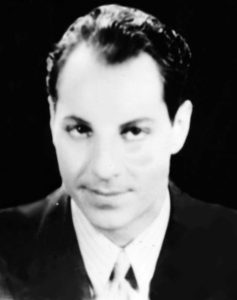 Usually cast in that most odious of musical comedy roles—that of the quasi-romantic juvenile lead—Zeppo, the youngest of the brothers, has about as much memorable screen presence as another Marx Brother, GUMMO: who, having left the act early on, never actually appeared in any of the movies. When Zeppo himself left the act after the brothers’ fifth movie, Duck Soup (1933), he was replaced in subsequent screen outings by equally vacant light romantic tenors such as Allan Jones, Kenny Baker, and Tony Martin (and if you don’t recognize the names of those warbling troubadours of yesteryear consider yourself fortunate).
Usually cast in that most odious of musical comedy roles—that of the quasi-romantic juvenile lead—Zeppo, the youngest of the brothers, has about as much memorable screen presence as another Marx Brother, GUMMO: who, having left the act early on, never actually appeared in any of the movies. When Zeppo himself left the act after the brothers’ fifth movie, Duck Soup (1933), he was replaced in subsequent screen outings by equally vacant light romantic tenors such as Allan Jones, Kenny Baker, and Tony Martin (and if you don’t recognize the names of those warbling troubadours of yesteryear consider yourself fortunate).
CHICO
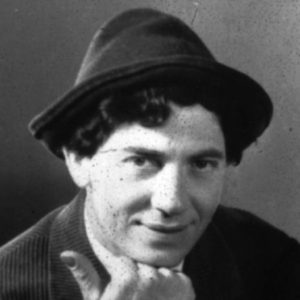 Eccentrically piano-playing, spuriously Italian-accented (“Ah, Shalom!”) con man-extraoardinaire Chico—with his curly black wig, tight-buttoned coat, and Tyrolean hat—is usually the only Brother who can consistently get the better of Groucho. Employing an endless facility for mangling the language with groan-inducing, painful puns, the eldest Marx Brother could talk his way out of any comic complication, usually involving light-fingered larceny, and then sit down at the piano for hilarious barrelhouse stylings including rapid fingernail-trailing glissandos, rolling bass-pounding smears, and—his trademark—‘shooting’ high octave keys with the index and thumb of his right hand.
Eccentrically piano-playing, spuriously Italian-accented (“Ah, Shalom!”) con man-extraoardinaire Chico—with his curly black wig, tight-buttoned coat, and Tyrolean hat—is usually the only Brother who can consistently get the better of Groucho. Employing an endless facility for mangling the language with groan-inducing, painful puns, the eldest Marx Brother could talk his way out of any comic complication, usually involving light-fingered larceny, and then sit down at the piano for hilarious barrelhouse stylings including rapid fingernail-trailing glissandos, rolling bass-pounding smears, and—his trademark—‘shooting’ high octave keys with the index and thumb of his right hand.
HARPO
 Last, but certainly not least, is the red fright-wigged, battered top-hatted, raincoat-wearing, and by turns childlike, adorable, mischievous, and malevolent silent clown, Harpo. Chasing anything in a skirt one minute and turning around and playing a soulful, virtuosic solo on his namesake harp the next, fist-whistling and horn-honking Harpo linked boisterous silent comedy on his end to his brothers’ dizzying dialogue, often acting as Chico’s partner-in-crime (out of make-up, the two oldest Marx Brothers, a year apart in age, looked virtually like twins). As undoubtedly the most musically and physically talented of the brothers, Harpo was key in bringing down the curtain on the drama part of the comedy—quite literally—and wreaking anarchic havoc on conventional plotting and dialogue.
Last, but certainly not least, is the red fright-wigged, battered top-hatted, raincoat-wearing, and by turns childlike, adorable, mischievous, and malevolent silent clown, Harpo. Chasing anything in a skirt one minute and turning around and playing a soulful, virtuosic solo on his namesake harp the next, fist-whistling and horn-honking Harpo linked boisterous silent comedy on his end to his brothers’ dizzying dialogue, often acting as Chico’s partner-in-crime (out of make-up, the two oldest Marx Brothers, a year apart in age, looked virtually like twins). As undoubtedly the most musically and physically talented of the brothers, Harpo was key in bringing down the curtain on the drama part of the comedy—quite literally—and wreaking anarchic havoc on conventional plotting and dialogue.
…
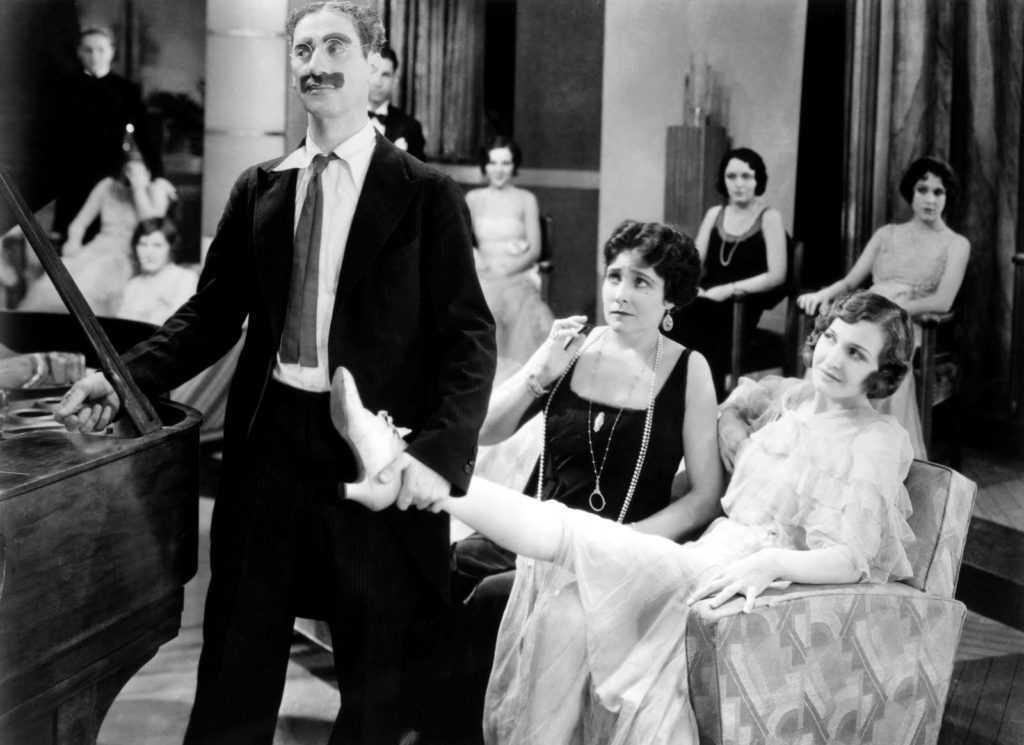
As for the movie I’ve chosen for the Marx Brothers, which is kind of an afterthought really, Animal Crackers was the second of two movies, following The Cocoanuts (1929) the year before, that were based on Broadway shows and shot on a soundstage in New York City. (Following their success, the Marx Brothers moved to Hollywood where they made three more movies of increasing quality, but decreasing popularity, for Paramount Studios.)
Here, the Marxes are really starting to come in to their own, and though some of the musical numbers (and non-Marx Brothers related story business) occasionally drags this early sound film down to moments of grinding boredom, one really gets the flavor here, perhaps because of its stagebound qualities, of what it would have been like to sit in the audience of an actual Marx Brothers show.
Wild, unruly, anarchic; the Marx Brothers delighted in taking the structure and conventions of the musical stageshow and turning ‘em on their ear. At the end, as Harpo takes his spray gun filled with a mysterious plant-based substance to each and every participant of this madcap merriness, even himself, and wealthy socialites and insufferable young lovers alike fall into, or more accurately surrender to, a dream-like stupor, the tyranny of that relentless and unforgiving mistress known as musical comedy has quite literally been usurped and destroyed.
Which, one suspects, had been The Brothers’ intent all along.

The Marx Family, New York City, ca. 1915. Left to Right: Julius (Groucho), Milton (Gummo), Mother Minnie, Herbert (Zeppo), Father Sam (Frenchy), Leonard (Chico, pronounced “Chick-o”), and Arthur (born Adolph; Harpo) Marx.

